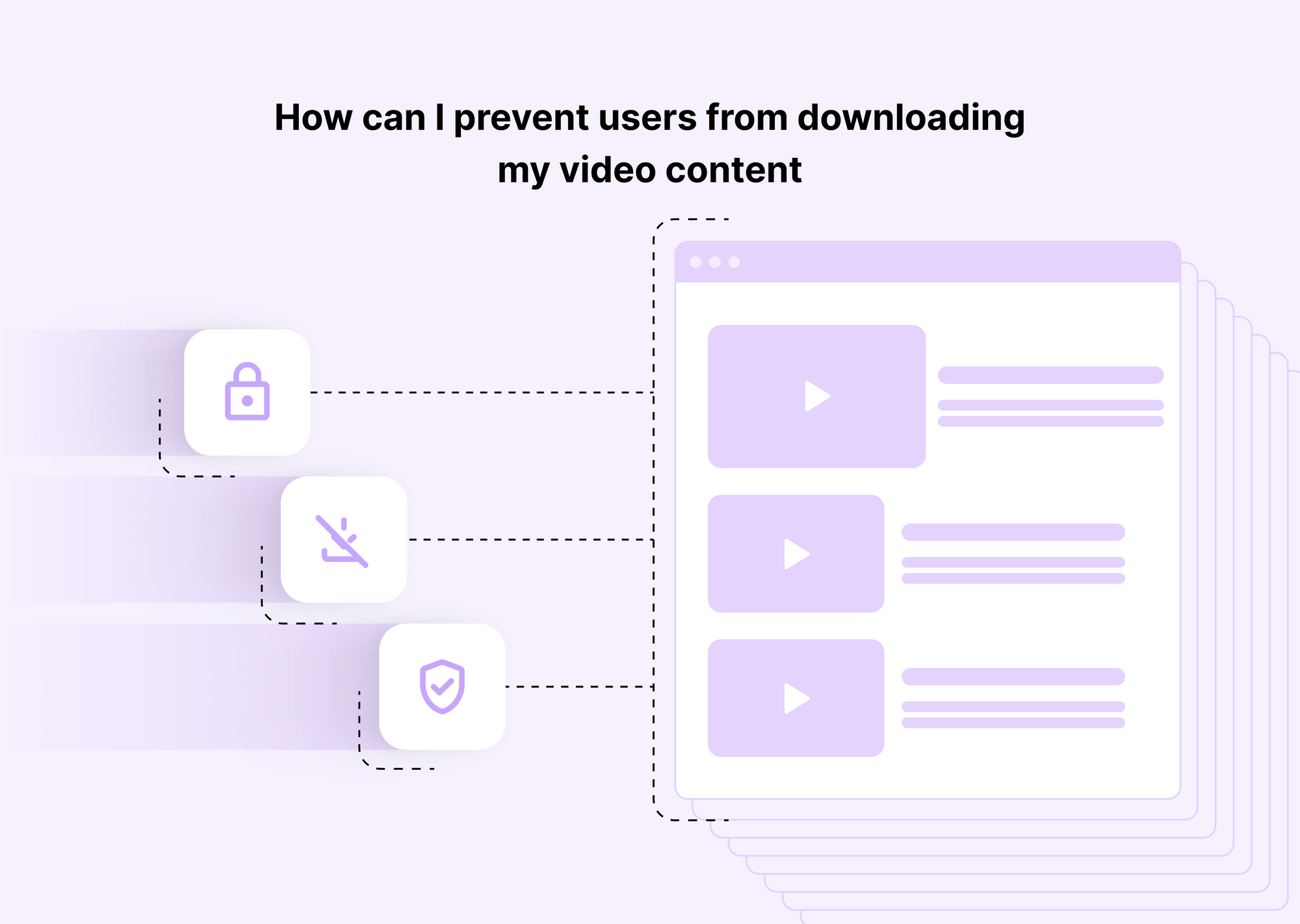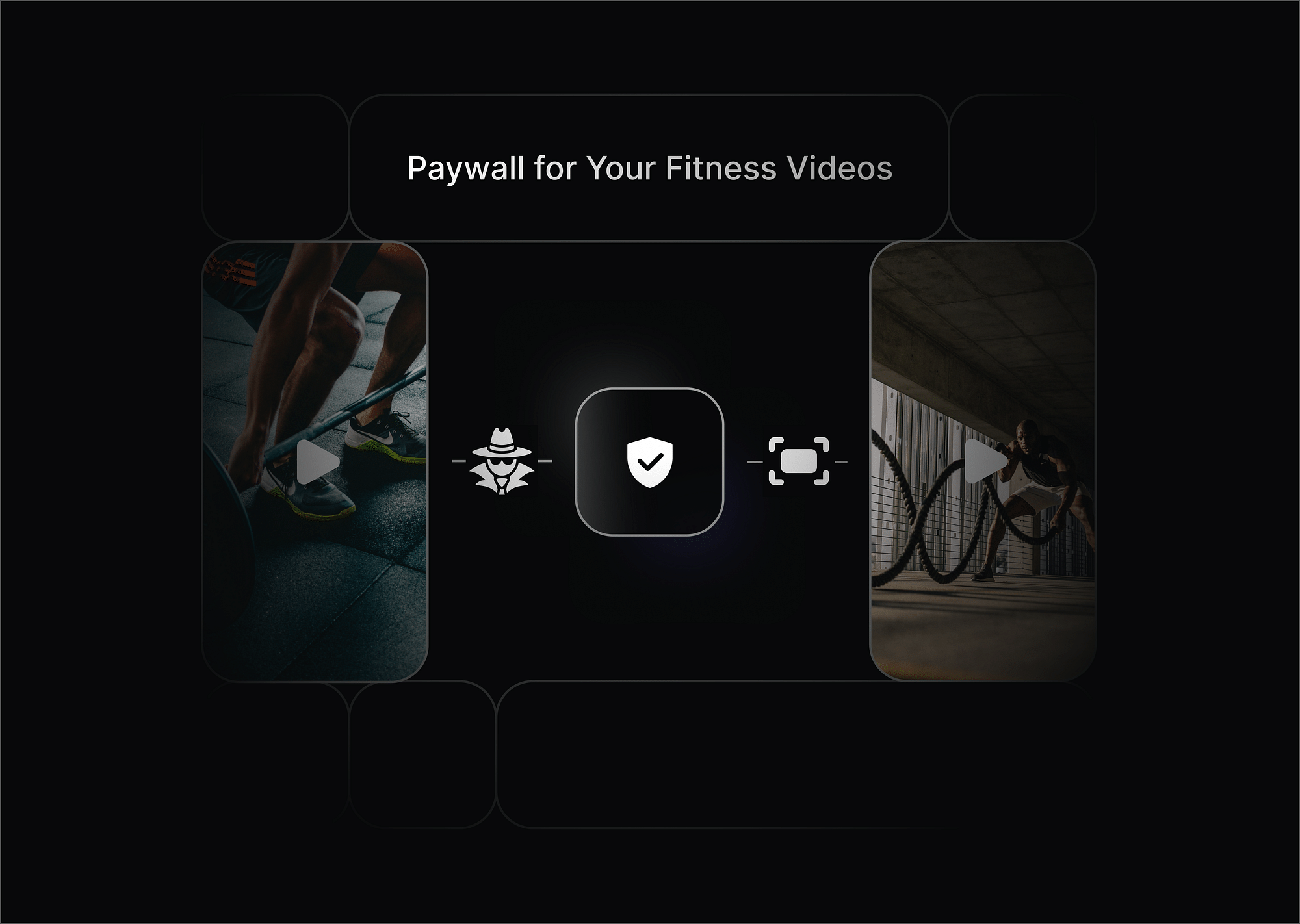As a course creator or fitness trainer, your video content is one of your most valuable assets. Whether you’re selling fitness plans, educational courses, or exclusive video content, it’s essential to protect your work from unauthorized distribution.
One of the most common ways content gets stolen is through screen recording. With just a few clicks, anyone can capture your premium video content and share it without permission.
But don’t worry, there are effective ways to block screen recording on hosted videos and prevent unauthorized distribution of your content.
Here’s how you can stop screen recording and secure your videos.
Why Screen Recording Is a Risk for Creators
Screen recording is a growing problem for fitness creators, course creators, and other small businesses using videos as their primary content. Here’s why:
- Easy Access: Many tools or apps (like OBS Studio, Camtasia, and built-in screen recorders) make it simple to record your content.
- Loss of Revenue: Pirated videos, once recorded, can be shared freely, leading to lost income and subscribers.
- Damage to Brand Integrity: When someone re-uploads or shares your content without permission, it undermines your brand’s value and can confuse or frustrate your audience.
So, the question is: How can you stop screen recording on your videos?
Let’s explore practical solutions.
How can you stop screen recording on your videos?
1. Use DRM (Digital Rights Management) for Video Protection
DRM is a set of technologies used to protect video content from unauthorized copying and distribution. DRM restricts how videos can be accessed, copied, or shared. Common platforms like Netflix, Amazon Prime Video, and Apple TV use DRM to prevent screen recording and copying.
- For video streaming: If you're uploading videos for streaming (like on platforms such as Vimeo, YouTube, or others), using a DRM system or using platforms that provide DRM protection (like Widevine, PlayReady, or FairPlay) is your best option.
- For file-based video: If you are selling or distributing video files, consider using a DRM solution that encrypts the video content and limits how it can be shared or copied.
Platforms like Gumlet offer DRM-based protection that encrypts your videos, making them nearly impossible to capture through screen recording.
DRM blocks screen recording tools from accessing or extracting your videos. It ensures that only authorized viewers can access your content in a secure environment.
2. Use Video Watermarking
Adding dynamic watermarking to your videos is a great way to discourage screen recording.
Watermarking can deter users from recording or sharing videos. If someone records your video, the watermark will appear on the recorded content, making it easier to trace the source.
- Dynamic Watermarking: In some cases, you can use dynamic watermarks that include information like the viewer's username, IP address, or timestamp. This can act as a deterrent because if someone records and shares the video, they can be traced back to the original viewer.
- Visible Watermark: A visible watermark can be placed in the corner or center of the video, making it less likely for someone to share or reuse the video without it being obvious.
3. Restrict Screen Recording with Web Technologies (for Streaming)
If you're distributing videos via a web-based platform, you can make use of certain technologies to disable screen recording:
- HTML5 Video Player with Protected Features: Some HTML5 video players can detect if screen recording is being attempted and can block or interfere with recording attempts. For example, you can use Encrypted Media Extensions (EME) in combination with a DRM provider to prevent screen capture.
- Disable Developer Tools or JavaScript-based Solutions: While not foolproof, some web-based video players can restrict the use of developer tools (which can be used to capture video directly from the browser). This can help reduce the likelihood of recording via browser tools.
4. Use Secure Video Delivery Platforms
If you're sharing videos with sensitive content, use secure video hosting platform like Gumlet that will provide additional protection layers.
Gumlet provides secure video hosting with features aimed at protecting your videos from unauthorized access and distribution. Below are some of the key features that Gumlet offers for secure video delivery:
- Password Protection: Set passwords for video access.
- Domain-Level Privacy: Restrict embedding to specific domains.
- Video Encryption: Secure your videos during storage and transfer.
- Customizable Privacy Settings: Control who can view or access the videos.
- Watermarking: Add watermarks to deter unauthorized recording.
- Secure Streaming: Encrypt video streams to prevent interception.
- Access Control & Expiry Dates: Limit video availability and control access duration.
5. Disable Right-Click and Download Options on Video Players
If you're hosting videos on your website, you can disable right-click actions or the ability to download videos directly from the player. This can help reduce the chances of someone downloading your video and then recording it.
- Disabling Download Links: Most video hosting platforms (e.g., YouTube) allow you to disable the download option, but this does not stop users from recording what they see on their screens.
6. Restrict Video Access to Specific Devices or Browsers
Restrict access to your videos by limiting the types of devices that can view your content. For example, you could:
- Limit access to certain browsers or platforms that don’t support screen recording protection.
- Use platform-based restrictions to stop your videos from being played on non-secure devices like mobile phones, which are easier to screen record.
7. Detect and Block Screen Recording Apps
While it's difficult to prevent all users from using screen recording software, you can create a more secure environment by detecting common screen recording software. Some platforms may integrate methods to detect and block known screen recording apps or browser extensions.
For instance, some custom-built solutions might include:
- Browser fingerprinting: Techniques that can detect when screen recording software is being used.
- Alerts for unusual screen behavior: Identifying when a screen capture app is interacting with the video.
8. Control Access with Login and Restrictions
Gumlet offers features to control access to videos effectively:
- Access Control: You can restrict video access by requiring users to log in before viewing the content. This ensures that only authorized users can watch your videos.
- Session Expiry: You can set expiration dates for video access. Once the session expires, users can no longer view or access the video, preventing ongoing access after a set period.
These features in Gumlet allow you to manage and control who can access your videos, ensuring more secure distribution.
9. Set Expiration Dates for Video Access
To prevent someone from recording a video and keeping it indefinitely, you can set an expiration date for when the video can be viewed. After that date, the video is no longer accessible. This method is often used in paid courses or subscription-based video services.
10. Educate Viewers and Users
Although this is not a technological solution, educating your viewers on the legal and ethical implications of screen recording and sharing videos can be an effective deterrent. Inform your audience that the content is copyrighted and recording or distributing it without permission is illegal.
Final Thoughts
In 2025, as a fitness creator or course creator, protecting your videos from screen recording is no longer optional—it’s essential. By implementing DRM, dynamic watermarking, and device restrictions, you can stop screen recording and ensure your content stays secure. Combine these protections with strong viewer education, and you’ll have a solid defense against piracy.
Try Secure Video Hosting with Gumlet
If you’re serious about protecting your videos, start with a platform like Gumlet. It provides DRM protection, watermarking, and much more to keep your workout videos safe from piracy.
FAQs
1. How can I stop screen recording on my videos?
To stop screen recording on your videos, you should use DRM (Digital Rights Management) technology, which encrypts your content and prevents unauthorized screen recording. Platforms like Gumlet offer built-in DRM encryption, making it difficult for anyone to capture your videos using screen recording tools. You can also add dynamic watermarking to identify the source of any pirated content.
2. Can I prevent screen recording on Mac devices?
Yes, you can prevent screen recording on MacOS by using secure video hosting platforms like Gumlet that offer DRM protection. Additionally, you can restrict screen recording in the system preferences under Security & Privacy > Privacy > Screen Recording. However, DRM is the most effective way to block screen recording at the source.
3. How do I stop screen recording on my iPhone?
To stop screen recording on your iPhone, you can restrict it through Settings > Screen Time > Content & Privacy Restrictions > Allowed Apps, and disable the Screen Recording option. For more comprehensive protection, use a video hosting platform with built-in encryption and DRM, such as Gumlet, which will prevent unauthorized screen recording from the app level.
4. Is it possible to stop screen recording on a Chromebook?
Yes, you can stop screen recording on a Chromebook by using secure video hosting services like Gumlet that provide DRM protection. You can also manage app permissions through Settings to limit screen recording functionality, but the most secure method is to host your videos on platforms that offer video protection.
5. What’s the best way to block screen recording on my workout videos?
The best way to block screen recording on workout videos is by using a secure video hosting platform that offers DRM encryption, dynamic watermarking, and signed URLs. These features make it much harder for users to record or share your videos without authorization. Platforms like Gumlet are excellent choices for this level of protection.
6. How can I prevent screen recording on my fitness streaming website?
To prevent screen recording on your fitness streaming website, implement DRM encryption, use secure video hosting with dynamic watermarking, and enable password protection. You can also restrict access to specific devices or regions to ensure your content remains secure. Integrating these tools will help stop screen recording and protect your valuable content.
7. Does DRM prevent screen recording completely?
While DRM encryption significantly reduces the chances of screen recording, no solution can offer 100% protection. However, DRM combined with other measures like dynamic watermarking, geo-blocking, and signed URLs provides the highest level of security to prevent screen recording and unauthorized sharing of your videos.
8. Are there any free tools to block screen recording on my videos?
While there are free tools available to block screen recording, they typically offer limited functionality. For comprehensive protection, it’s best to use secure video hosting platforms like Gumlet that provide DRM encryption and watermarking as part of their service. Many of these platforms offer affordable pricing, and some even provide free trials to test their features.




